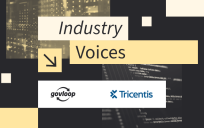This blog post is an excerpt from a sponsor of our latest IT modernization guide.
It’s no secret that most agencies today still rely on legacy infrastructure that was designed and deployed 20 years ago or more — long before cloud, mobile, or the Internet of Things were buzzwords. Why is it, then, that so many legacy systems live on instead of being replaced?
It’s simple, really. Existing infrastructure continues to support integral agency missions. As long as critical data and processes remain trapped there, it’s not going away.
The good news is, legacy technology hasn’t necessarily outlived its usefulness. In fact, the systems of the past are often the very thing you need to meet critical mission obligations on-time and deliver services to citizens effectively. You must bridge the gap between old and new.
To learn how IT modernization can be that bridge, GovLoop sat down with Shawn Ryan, Vice President, Product Marketing Digital as a Service, at Axway, a company that helps agencies modernize and adapt their technology.
“While IT modernization might seem daunting, it doesn’t have to be,” Ryan said. According to him, there are three quick wins an agency can tackle to make any IT modernization challenge seamless: leveraging an API first strategy; offering Integration-as-a-Service to empower both developers and department organizations; and enabling the digital workplace with a content collaboration platform.
To start with, API management is critical to focus on because APIs simplify the connection and reuse of services between existing IT infrastructure and modern applications.
This frees data trapped in legacy systems and provides a flexible and cost-effective integration layer on top of older architectures to enable new citizen experiences that meet business and mission goals.
“Managing the full lifecycle of APIs is a key step towards opening up legacy infrastructures and to overcome the pace barrier for innovation,” Ryan explained.
Offering Integration-as-a-Service is a strategy to integration that is also critically important. This strategy refers to IT offering centrally governed integration capabilities to support application, data and process integration projects.
“By offering Integration-as-a-Service, you are now enabling different departments to access and to create their own integrations,” Ryan said. “You’re allowing them to do integration work themselves with IT overseeing and governing. This achieves economies of scale and economies of pace.”
Finally, Ryan explained that enabling the digital workplace with a content collaboration platform is essential when it comes modernization. “A modern content collaboration platform allows users to be productive no matter how the users want to work. Many of today’s solutions force users to the web, but users need the freedom to work the way they want; on any desktop, device or browser.”
While empowering the end user, a modern collaboration platform needs to have strong data governance capabilities – including the ability to leverage cloud, on-premise, private cloud storage or any combination – based on security and data protection requirements. “One size does not fit all, and government IT executives need the flexibility to adapt to change without disrupting end users.”
An easy-to-use and easy-to-manage file sharing and content collaboration solution will help you improve data agility and workforce productivity while lowering costs and protecting data across your entire digital ecosystem.
Axway offers AMPLIFY, a hybrid integration platform, that can help any agency with these IT modernization quick wins. AMPLIFY unifies employees, partners and developers to create a powerful network to meet ever-changing citizen demands. AMPLIFY provides a rapid microservices and API creation tool, a governance layer to secure APIs and manage their lifecycles, a self-service developer portal to drive API adoption and embedded analytics to identify abnormal situations and usage trends. AMPLIFY unified by the above supports key integration disciplines including Managed File Transfer, B2B/EDI integration and API-led integration along with an API enabled hybrid-cloud content collaboration solution.
“Innovation is not always going be just accessing data from existing legacy systems,” Ryan pointed out. “Innovation will often require new services to be built fast. AMPLIFY and Axway can help in the building of and managing of new APIs and Microservices while providing a common secure policy-based service layer for the old and the new.”
It’s true that a significant shift to cloud, mobile and IoT technologies is taking place in the public sector, and it’s redefining how agencies must collaborate, innovate and compete. But you don’t need to change everything all at once. These three quick win approaches will help move your agency into a modern infrastructure for the future.






Leave a Reply
You must be logged in to post a comment.